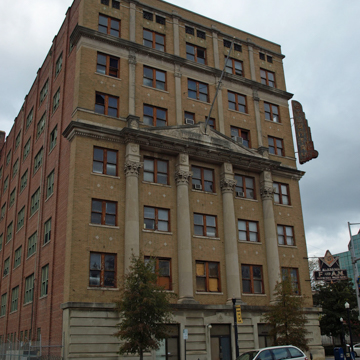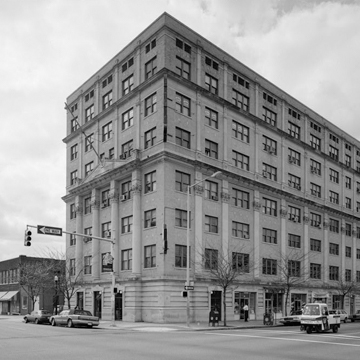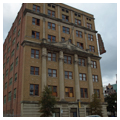You are here
Masonic Temple Building
Towering above neighboring structures in Birmingham’s historically black Fourth Avenue business district, the Masonic Temple Building suggests the prestige and vitality of Freemasonry among African American Alabamians during the early twentieth century.
Eight or ten local African American lodges were already in existence by 1870, when the “Colored Grand Lodge in Alabama” was organized in Mobile under the auspices of the Grand Lodge of Ohio (due to the absence of local white sponsorship). Thereafter Freemasonry thrived, with lodges springing up not only in places like Mobile, Montgomery, Selma, Huntsville, and upstart industrial Birmingham, but also in rural communities scattered across the state. All would eventually come under the umbrella national organization named for Prince Hall, the first Worshipful Master of America’s first black lodge, established in Boston in 1784. As Birmingham surged forward after 1900 to become Alabama’s largest city, African American Masons determined to build a statewide headquarters there, a flagship building that would also be a commercial venture offering rental space for black businesses and professionals. A large public meeting space would also be provided in a city and state where most such venues were unavailable to blacks.
Grand Master Walter T. Woods spearheaded the project. Planning began in 1913, though construction would have to wait several years more as funds were slowly raised from Masons throughout the state. Two members of the Tuskegee Institute architectural faculty, Robert Robinson Taylor and Louis H. Persley, were engaged to develop drawings and specifications. Taylor, a native of North Carolina and the son of a carpenter, was the first black student to attend MIT. Under his eye, in collaboration with Institute founder Booker T. Washington, the Tuskegee campus had taken shape over the previous two decades. The much younger Persley was from Georgia, a 1914 graduate of Carnegie Tech in Pittsburgh who had returned South to join Washington and Taylor at Tuskegee.
The cornerstone for the Birmingham Masonic Temple, officially named the “Most Worshipful Prince Hall Grand Lodge of Alabama,” was laid with appropriate ritual in 1922. A steel-skeleton structure seven stories in height (plus raised attic), the form of the building was conceived by its designers as essentially a large, quadrilinear commercial edifice. Its larger purpose is symbolically suggested by the thin neoclassical applique that wraps around its two street fronts. Yet the effect is achieved somewhat awkwardly, as pilasters, pedestals, and intervening entablatures stretch to accommodate the functional demands of a many-windowed, multi-storied structure that was to be at once institutional, ceremonial, and commercial. The limestone-faced ground floor of the building is treated as a classical podium (curiously punctuated by narrow storefronts) that projects slightly at the main entrance to carry four engaged Corinthian columns. Rising through four of the seven stories to an abbreviated pediment flattened against the buff-colored brick facade of the building, the columns announce the main entrance. Inscribed in the tympanum of the pediment is the name by which the building was known in the beginning, the “Colored Masonic Temple.”
Built by Windham Brothers, a Birmingham-based construction company, the Temple was completed, debt-free, in 1924 at a total cost of $658,000. Besides housing state headquarters for Prince Hall Masons, the building accommodated the offices of other black fraternal groups including Freemasonry’s counterpart for women, the Order of the Eastern Star. Physicians, lawyers, dentists, insurance agents, and lawyers leased space elsewhere in the building. Three ground-floor rooms were occupied by the Booker T. Washington Library, the first lending library open to black citizens of Birmingham. Adjacent was a popular drugstore and “soda fountain,” and in the basement was a billiard hall. Besides being the setting for Masonic rites, the 2,000-seat “grand auditorium” occupying the second and third floors hosted concerts—Duke Ellington and Count Basie were regulars—as well as dances, mass meetings, and other special events. In time, the building would figure in the civil rights struggle as it sheltered the offices of the NAACP, the Southern Negro Youth Congress (SNYC), the Right to Vote Club, and the Jefferson County Negro Democratic Youth League. Activist civil rights attorney Arthur Shores also had his offices in the Temple Building.
In recent decades, with the decline of Freemasonry, a building that once figured prominently in a vibrant black urban life has faced a sort of functional obsolescence. Current plans envision an eventual repurposing of the structure as part of the general revitalization of downtown Birmingham. The Masonic Temple Building is listed on the National Register as part of the Fourth Avenue Historic District.
References
“Colored Masonic Temple,” Jefferson County, Alabama. Historic American Buildings Survey, National Park Service, U.S. Department of the Interior, 1993. From Prints and Photographs Division, Library of Congress (AL-37).
Satterfield, Carolyn Green. Historic Sites of Jefferson County, Alabama. Prepared for the Jefferson County Historical Commission. Birmingham: Gray Printing Company, 1976.
Stanton, Mary. “Birmingham’s Most Worshipful Prince Hall Grand Lodge.” Alabama Heritage, no. 123 (Winter 2017).
Weiss, Ellen. Robert R. Taylor and Tuskegee: An African-American Architect Designs for Booker T. Washington. Montgomery: NewSouth Books, 2012.
Writing Credits
If SAH Archipedia has been useful to you, please consider supporting it.
SAH Archipedia tells the story of the United States through its buildings, landscapes, and cities. This freely available resource empowers the public with authoritative knowledge that deepens their understanding and appreciation of the built environment. But the Society of Architectural Historians, which created SAH Archipedia with University of Virginia Press, needs your support to maintain the high-caliber research, writing, photography, cartography, editing, design, and programming that make SAH Archipedia a trusted online resource available to all who value the history of place, heritage tourism, and learning.



















